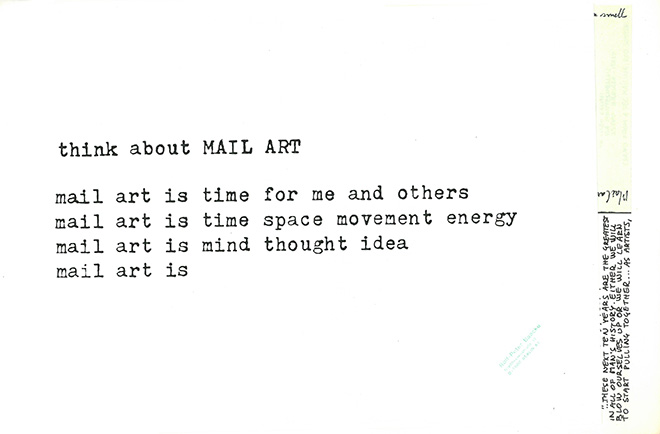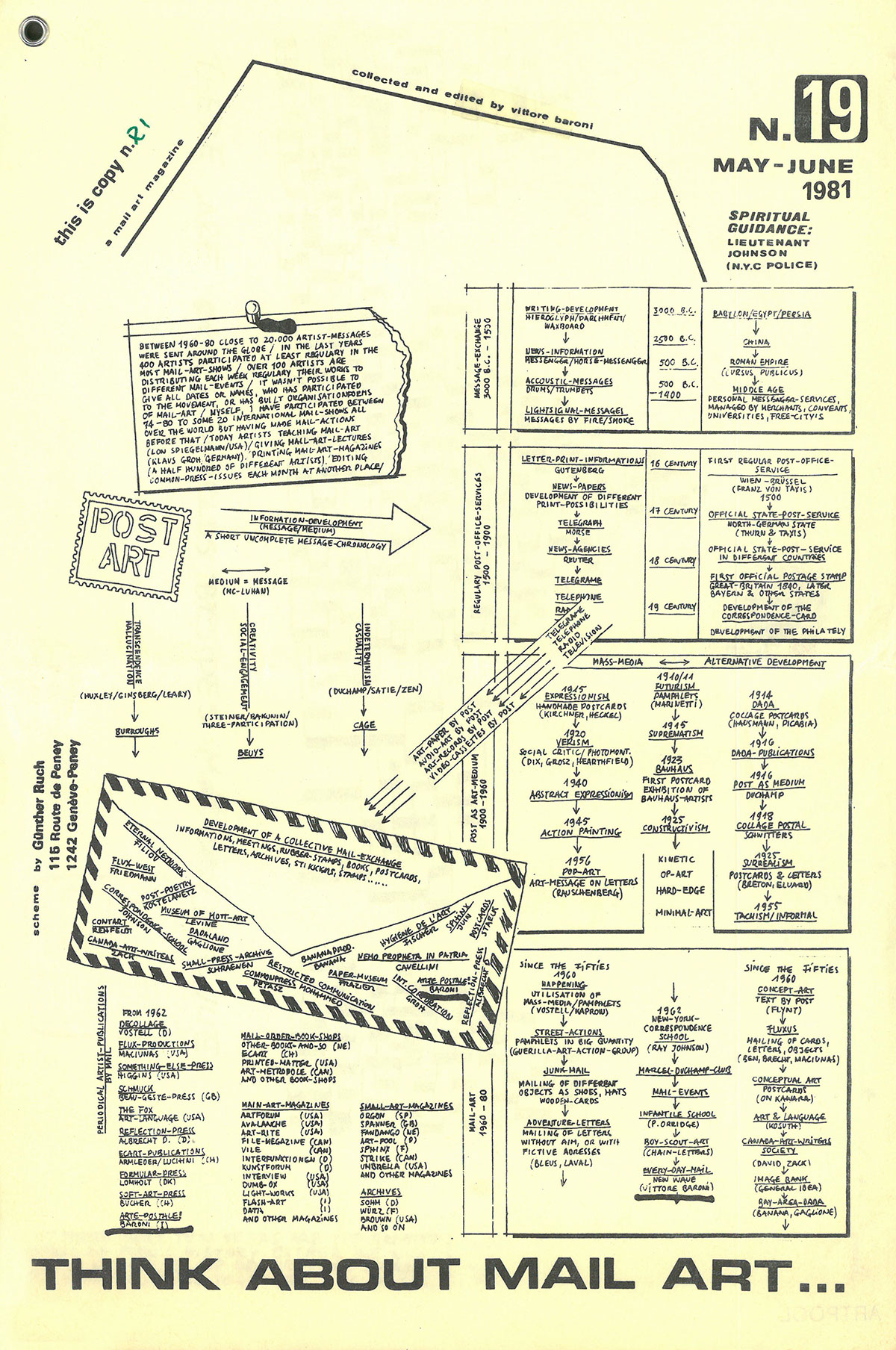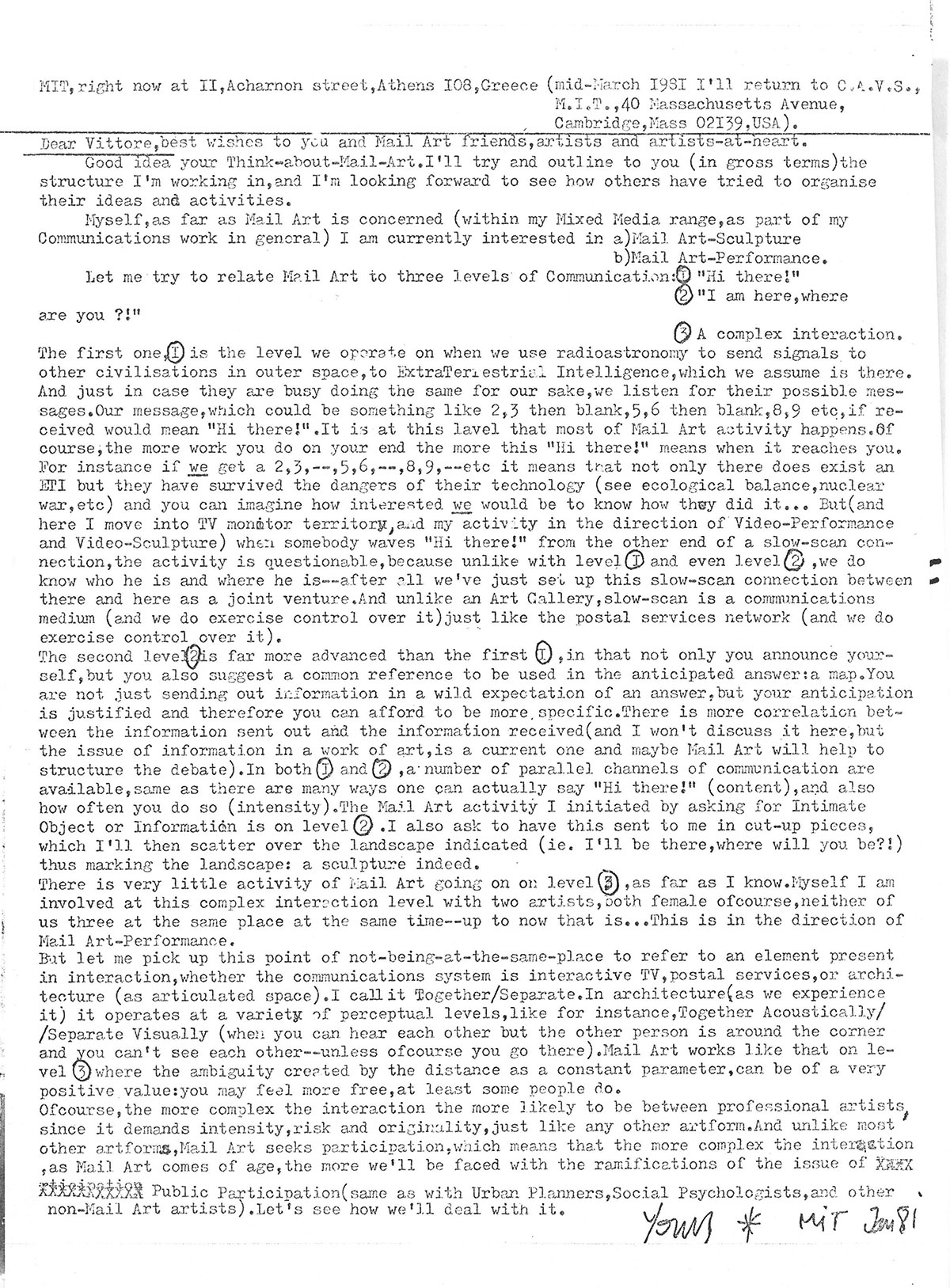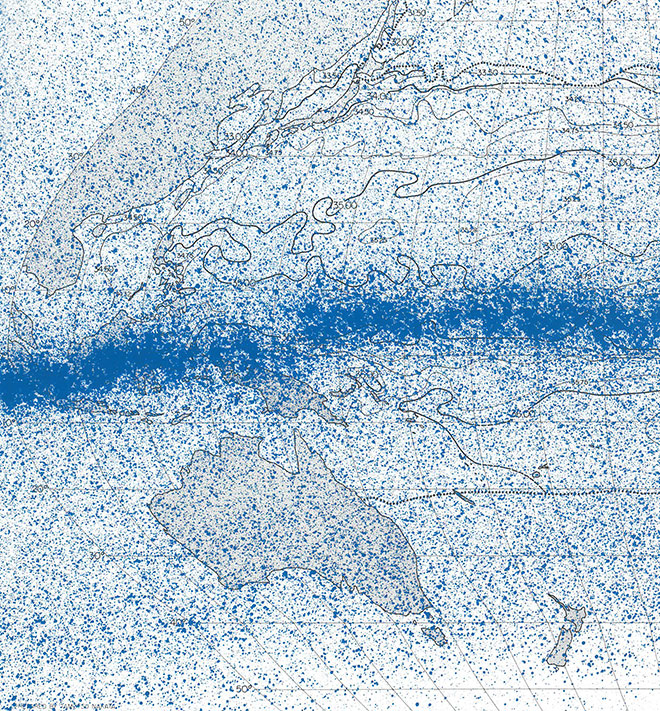Mit Mitropoulos: Networks with and without technology:
on the relationship between mail art and telecommunications art
Mit Mitropoulos: Networks with and without technology: on the relationship between mail art and telecommunications art, in: Eternal Network. A Mail Art Anthology, University of Calgary Press, Calgary, 1995, pp. 171–175. (Ed. by Chuck Welch)
Mail art was a natural for me, because I come from the networks background of growing up on ocean-going boats, and my extended family were so many coloured pins on a world map – themselves never in one place for very long. Similarly my Ph.D. work at Edinburgh University in 1974 the study of Space Networks.[1]
When my female models and I found ourselves geographically separated due to today’s lifestyles, we started creating and exchanging cultural objects by post to keep our energy flowing over distances. My models had to assume my presence over the distances; they used my mailed suggestions and materials to perform and record that performance. Later on I became aware of mail art as an established activity with a name, joined it, and referred to my artist-mode] work as MA-performance,[2][3] which I extended to include models I had never met at the time, or ever will again.

Work by Rolf-Peter Baacke, in: Arte Postale! No. 19. Think About Mail Art, Italy, 1981 (Ed. By Vittore Baroni)
As an environmental artist and communications researcher, since 1979 have pursued parallel work in mail an and telecommunications art, the latter activity falling within the art-science-technology context. I owe mail art, because besides the pleasure of being part of the mail art network, mail art, as compared to telecommunications art, proved high in privacy (necessary for the intimate communications of artist-model) and low on logistics. Mail art was much cheaper, no special equipment was required (no compatibility problems either), and simultaneous performances in different parts of the world could be arranged. In one of my simultaneous performances, for example, three models performed separately, but simultaneously in three different time zones. Conceptually together, but geographically separate, one model (Pat Larter) was in Sidney, Australia, another model (Anne Queudeville) was in Caen, France, and the third model (Rini Rubini) was in San Diego, California.
In later years I had incorporated mail art material into telecommunication art processes, and managed to gain an insight into communications processes in general. The latter I articulated and started feeding it into telecommunication art as early as 1981.[4] At the time I was a Research Fellow at Center for Advanced Visual Studies at the Massachusetts Institute of Technology (M.I.T.) and involved in research on communication aesthetics. I also worked as communications consultant during the 1979- 1985 period for Educational Video Resources of M.I.T. on issues relating to organization of space using telecommunications, was a member of the city of Cambridge/USA Cable TV Commission, and did the research for UNESCO on 2-way interactive cable TV systems in the USA.[5] These cable TV research projects remind me of the Reading, Pa/USA Cable TV system, an excellent example of technology suited to a public policy strictly for the benefit of the public. The mayor at the time, Karen Miller, described the system as “great community, although bad TV,” and this is what mail art activity is to me: high on community, low on aesthetics.
I believe in a twin identity for mail art: one, the everlasting, big, open, invaluable network of easy access, and two, some specific, demanding activities for in-depth exploration of the mail art process. The first one defines mail art as a “cultural phenomenon,” will get you a bulky archive in no time, a long list of addresses, and the daily feeling of an ever-replenished community. This must be preserved at all costs. The second one is as demanding and fulfilling as any other creative activity either in art, science, or technology. Both identities afford us a relatively logistics-free platform to do research on communications.
Telecommunication artists, especially those who don’t have any other communications background, have a lot to learn from entering the mail art networks, which means that mail artists have an advantage, if they see it and use it. For instance, having realized that meaningful communication was becoming inversely proportional to the growing channels of communication (whether with or without technology) made me take a look in the early 1980s for other mail artists with concerns similar to mine. But the replies I was getting to this think-about-mail art effort are best characterized by Vittore Baroni’s answer (following his Think About Mail Art project) when I pressed him[6] with a text making an analogy between mail art and CETI (Communications with Extraterrestrial Intelligence). He replied with a mixture of humor, social wisdom of the time and exasperation: “Well, who cares? I am not Batman!” and I loved it. Clearly it was five years too early for reflection.[7][8]

Cover, in: Arte Postale! No. 19. Think About Mail Art, Italy, 1981 (Ed. By Vittore Baroni)

Text by MIT Mitropoulos, in: Arte Postale! No. 19. Think About Mail Art, Italy, 1981 (Ed. By Vittore Baroni)
Today, more mail artists look into science, and even more are using communications technology. Therefore, it seems to me the right time to briefly go through art-science- technology, at least the version I have been operating in. It is certainly not art as it used to be, where we simply would now produce it by referring to scientific processes or by using high tech tools (which would mean that aesthetics remained the same). Nor is it a cultural product as it used to be, now simply transported over a distance via a communications channel (which would also mean that aesthetics remained the same). It is the reciprocal influence of art on science and technology. For instance, artists experience daily the electronic space[9] reality, so it is only inevitable that new aesthetic elements will emerge — much to the chagrin and disagreement of the art market. Mail artists could contribute very well from their experiences.
Drawing from the network processes I’ve been involved in,[10][11] have summed up three new elements for New Aesthetics: 1) Control (of the networks, for instance); 2) Knowledge (as processed information); 3) Three Levels of Complexity of Interactivity: “Hi there!” (acknowledgement, without necessarily pursuing the exchange), “I am here! Where are you?!” (establishing common references, towards complex interaction), and finally Complex Interaction. I have used these three elements in MA-performance, interactive video installations, and for Geopolitical Art like my project Line of the Horizon.
Science itself has moved from just separating things (and putting them into some order for our understanding and for solving problems) into focusing on the connections between things. In science there is beauty in simplicity: the simplest solution to a problem is very often the correct one.[12] Similarly, the simplicity of the Pioneer-6 design is now being appreciated. Launched in the mid-1960s with an expected lifespan of six months, Pioneer-6 lent a helping hand to the landing on the moon (by locating solar storms), and is still operating. And I have just returned from a medicine-science-technology meeting (Advanced informatics in medicine, for the European Community) in Sevilla, Spain, where the confidentiality issue was strongh raised: the wide use of computers will make it impossible for patients to refuse their consent for having data on them stored in a computer. Terrorists, it was further hinted, may kill a politician through manipulation of his medical cart- data card.
Technology is not all benefits. Privatization of computers has brought triviality. PCs, falling prey to human error, can also be targeted for attacks (intentional human errors). This is especially dangerous in computer networks and two-way “response” systems.[13] Certainly it is not enough for artists to set up communication networks. The military and financiers have done it before us. We need to work on the content of interactivity as well. Otherwise, if we remain passive, the medium will remain the only message. On the other hand, since the setting up of a network for technology- mediated communication is both time-consuming and expensive, we naturally expect a proportionally consistent content. The geopolitical art project “Line of the Horizon” for example, has, since we carried it out in 1986, been presented to a telecommunications conference, an aesthetics conference, and is being published in a Science of Human Settlements review. It focused on the Mediterranean, then extended for 8,500 nautical miles. It was ten months of work, from original concept to collected data evaluation. The network of twenty-seven participant nodes (twenty-one Mediterranean cities, and two of the rest were ships in oceans flanking the Mediterranean.) and their compatible telefax equipment took 6.5 months to set up, and was activated for 6.5 hours. An east-west exchange of respective lines of horizon created a conceptual horizon from the Indian Ocean to New York, through the Mediterranean. Since in a network each node is both center and periphery, our facsimile network could have been activated from any node (which proved very useful when we were faced with administrative problems of control in the node we were situated).

Work by Róbert Swierkiewicz, Arte Postale! No. 19. Think About Mail Art, Italy, 1981 (Ed. By Vittore Baroni)
Line of Horizon was a geopolitical art project[14] in the art-science-technology context, the same as with current proposals in progress: they relate to the survival of the Mediterranean sea turtle, the division of the island of Cyprus by occupation forces, citizen participation in mass media, and the movement of the Earth as related to the 1992
European Union (Fig. 99). As in mail art, “Line of Horizon” was operated on a planetary scale. But we were simultaneously live. The 6.5 hours of activation had us operate in six different time zones simultaneously. In telecommunications art, unlike receiving mailed messages, there is hardly time for reflection, so you need to be prepared for a variety of alternatives, and have internalized the communications process well. Such live communications can either be limited to a pre-arranged exchange, like respective lines of horizon, or involve a more complex interaction that may develop.
Artists, scientists, technologists, we are all faced with the challenge of the planetary dimension, and the challenge of use of technology. Today’s technology, since communications tech merged with information tech in the mid 1950s, is what use we make of it. It is what Merlin the magician was in the Excalibur era: a blessing to some, a curse to others. Networking makes it possible to listen to a loved one’s voice as s/he whispers over continental distances. Similarly, in one day an infection can take world-wide proportions: AIDS is as much a current term as a CETI, or INMARSAT,[15] or a PCN.[16] PCNs should start becoming available, allowing for person-to-person communication, and allowing us to be permanently in touch. But how desirable is this? How can we retain control—which will further allow us to choose, for example, to retain the participatory democracy that two-way interactive cable TV systems can offer?[17]
I will conclude this brief, autobiographical essay by expressing how lucky I feel to experience today’s networking. It follows the natural human development from the obsidian prototraders[18] to the eighth century B.C. Greeks who organized human settlements in the Mediterranean, to the navigators Dias, Columbus, Magellan of the fifteenth century, and others up to the eighteenth century, to today’s exploration beyond the solar system. In the current geopolitical reality, access to communication networks, with and without technology, can be assured. Let us use it creatively and wisely.
__________________
[1] In Space Networks space is considered as a network, and not space-as-place.
[2] MIT Mitropoulos, “Towards Performance,” M. I. T. Humanities, Cambridge, Massachusetts, 1980.
[3] Niti Salloway, “Dear MIT,” book review of ‘Towards Performance,’ R.Ho.K. poster, Flemish School of Fine Arts: Brussels, Belgium, 1980.
[4] Eiric Gidney, “Artists Use of Telecommunications,” correspondence with this author, Leonardo, 1983, 16:4.
[5] MIT Mitropoulos, “Public Participation as Access, in Cable TV in the U.S.A.,” in ‘Communications With and Without Technology,’ Ekistics, October, 1983, 50:302, 385-392.
[6] "Dear Vittore,” in ‘From Communications to Telecommunications,’ Pocket Guide to the ‘Line of the Horizon’ project, Ministry of Culture, Greece, 1986.
[7] Chuck Welch’s, Networking Currents: Contemporary Mail An Subjects and Issues, Sandbar Willow Press: Boston, Massachusetts, 1986 reflects, in part, a philosophical, critical investigation into the phenomenon of networking art.
[8] Günther Ruch’s, “International Mail Art Network,” and “Sightseeing,” Clinch, Geneve-Peney, Switzerland, Nos. 7-8,1985, documented, as did Welch, international networking projects.
[9] Electronic space is one type of Behavioral space, which at the turn of a switch or the push of a button is turned on or off. Behavioral space is the space as each one of us experiences it by being involved in an activity in it. This is in contrast to Euclidean space that is independent of anybody ’ s behavior in it, and is described/measured in feet or meters.
[10] MIT Mitropoulos, “On Interactivity,” in Theo van der Aa, ed., DigitalMediaand the Arts,The Netherlands: Limburg University, 1985.
[11] MIT Mitropoulos, “Aesthetics Reconsidered: Electronic Space, Mail Art, and Spaces for Communications,” unpublished paper, CAVS, M.I.T., Boston, Massachusetts, 1983.
[12] MIT Mitropoulos, “Network Aesthetics,” Ekistics, 55:330- 331, May-October, 1988.
[13] Moreton Moore, “On Beauty in Science,” International Aesthetics Congress, Nottingham University, England, 1988.
[14] A two-way interactive system differs from two-way response system. The former allows for either side to initiate the exchange. The latter has one side alone capable to initiate it, whilst the other side is best defined by its memory, from which it is called to retrieve specific information by responding to the caller (example: videotex). In the QUBE cable TV system (of Columbus, Ohio fame) the computer responds to subscribers, and its memory gradually builds a profile of each one of them according to their requests (what to buy, what to see, whom to vote for, etc.). That information may be sought by commercial organizations for gain, or national security agencies for purposes of control.
[15] A poster document on geopolitical art printed on the occasion of a slide presentation I did in 1989 can be requested from M. Santorineos, Art-technology section, Contemporary Arts Center I.T., 48 Armatolon + Klefton, Athens II47I, Greece.
[16] INMARSAT is the International Maritime Satellite Organization. It allows ships and mobile land units to check automatically on their latitude-longitude. It also picks and locates sources of distress signals in all oceans.
[17] PCNs are superphones of the Personal Communications Network, which uses ultra-high-frequency radio bands. Through them we will soon have a personal number rather than one home number, a second office number, etc., as in today’s fixed-wire networks of place-to-place.
[18] MIT Mitropoulos, “Implications of Cable TV for Participatory Democracy,” Cities, England, May 1985.
